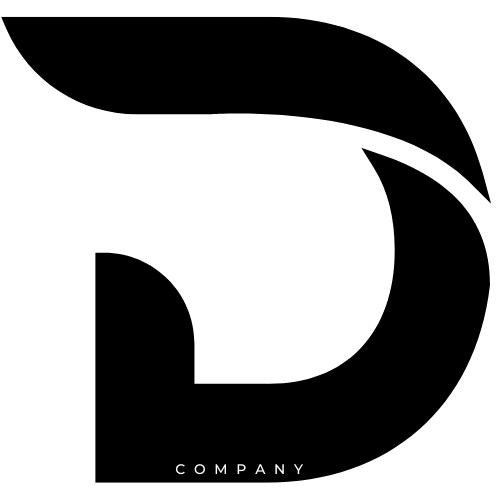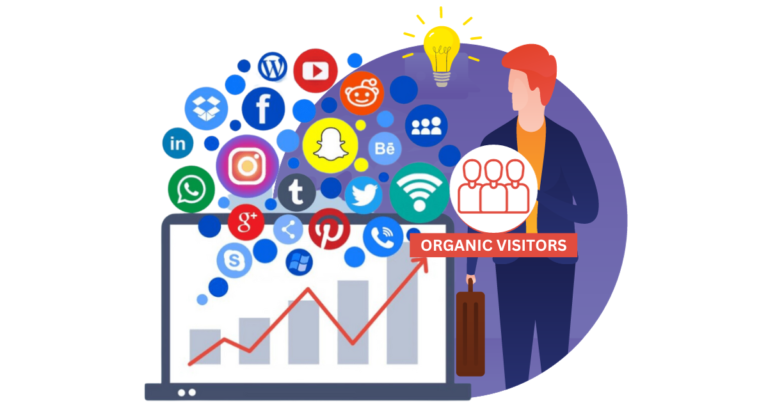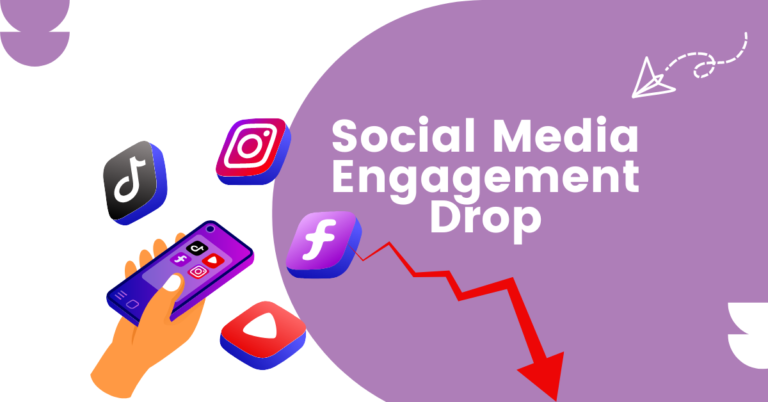It’s virtually impossible to run a small business without marketing on social media. But social media marketing that you have to do is only a fraction of your task for the day. Tiny little baby fraction. That’s why I’m going to help you learn the basics of social media marketing that can increase sales in the short and long term.
Types of Social Media Marketing Services
Services for social media marketing (SMM) include a variety of tactics and endeavors meant to advertise companies on different social media networks. The development of interesting and pertinent information to draw in the intended audience is one essential function, along with content curation. Another essential service is social media advertising, which entails the development and administration of paid campaigns to raise brand awareness and encourage particular actions like clicks or conversions.
Services for social media management concentrate on managing a business’s online presence on social media, including setting up accounts, planning postings, and interacting with the community. Analytics and reporting services are essential for gauging the success of social media marketing initiatives since they offer insightful data on audience behavior and campaign outcomes.
Influencer marketing services also entail working with well-known people on social media to endorse goods and services. Together, these different services make up a comprehensive social media marketing plan designed to improve a small business’s online visibility and interaction.
Identify the goal you hope to achieve
Now, to do any job, you have the right tools. All right? A key tool. In it, you’ll find ten different templates, some of which we’re going to go over in this content. So it’s worth grabbing now so you can follow along. When it comes to social media marketing, the first thing you want to identify is the goal you hope to achieve.
Social media can increase awareness of your product. It can also be used to make sales. It can drive leads to your website, or it can simply help build your brand in the minds of millions of customers. All of these are good things that can lead to more business.
But unless you have a whole team of marketers working on your social media, you want to start with just one or two goals. Don’t be super ambitious at this stage. You know what I’m saying? A good way to consider which goals to go for is to think about short and long-term results.
Short term results
Short-term results are things like direct sales or lead generation that can become sales rather quickly if your business needs a quick injection of cash or you have a special promotion that needs juice right now. Revenue-direct social media campaigns can be highly effective, but unfortunately, there’s often a limit to how many leads and sales you can accumulate with a small audience. And even paid campaigns can have their limits before the cost per action becomes too high.
Long term results
That’s why it can be better in the long run to focus your social media resources on building brand efforts. These activities are defined by goals like awareness, engagement, and public sentiment that aren’t tied to an immediate revenue metric, but will in time, open your business up to far more sales than would have been possible using short-term social media marketing alone.
Decide which platform to use
It can be intimidating to navigate the SMM service provider landscape, akin to trying to find the ideal needle in a hashtag haystack. Don’t worry, though, tiny company owner! Here are some important things to think about in order to make sure you choose the best companion for your social media journey.
Determining the “top 5” platforms for social media marketing services depends on your specific needs and goals. Different platforms excel in different areas, and the best ones for you will depend on factors like your target audience, industry, budget, and desired capabilities. However, here are five popular and powerful platforms worth considering, each with its unique strengths
Sprout Social:
Known for its all-in-one approach, Sprout Social offers scheduling, publishing, engagement, analytics, and reporting tools for all major social media platforms. It shines in team collaboration and social listening features, making it ideal for agencies and larger businesses.
Advantages of Sprout Social
- Outstanding user experience: Switching between several social accounts and functions is a joy with Sprout Social’s clear, simple, and easy-to-use design. Compared to some competitors, many users find it simpler to understand and get the hang of.
- Extensive features: Sprout Social provides an extensive feature set for social media management, which includes social listening, engagement tools, analytics, reporting, team collaboration, and post-scheduling. It serves as your one-stop shop for all things social media.
- Robust reporting and analytics: Sprout Social offers comprehensive reporting and analytics that provide you with important information about the effectiveness of your social media initiatives. You can use this data to measure your strategy’s effectiveness and optimize it.
- “Smart inbox”: This feature streamlines your communication workflow by making it easier to manage messages and discussions across several platforms.
- Perfect for teams and agencies: Sprout Social works great for teams and agencies that oversee several social media accounts for various clients. Effective teamwork is made simple by the authorization controls and team collaboration tools.
Disadvantages of Sprout Social
- Higher price point: With monthly plans beginning at $249, Sprout Social is more costly than some other social media management solutions. This can put off smaller companies or those with tighter resources.
- Few platform integrations: Sprout Social is available on all the main social media networks, however, it is not integrated on certain niches or newer sites. Businesses with substantial investments in certain particular platforms may find this to be problematic.
- Not the best for necessities: The feature set and cost of Sprout Social may be too much for you if you simply manage a few accounts and have basic social media needs. Simpler and less expensive tools could provide higher value.
- Some customers have noticed sporadic problems and issues in the platform, which can cause frustration and interfere with workflow. Sprout Social, on the other hand, is frequently regarded as dependable and refreshes its software.
Hootsuite:
Another comprehensive platform, Hootsuite boasts expansive social media coverage, including lesser-known platforms like Reddit and TikTok. Its strength lies in managing multiple accounts and automating tasks, perfect for agencies or businesses juggling numerous social media presences.
Advantages of Hootsuite:
- Centralized Management: Without having to log in and out of several platforms, Hootsuite offers a centralized platform for managing many social media accounts, making it simpler to plan posts, keep an eye on activity, and interact with followers.
- Time-saving: Setting up posts ahead of time guarantees a steady social media presence while also saving time. It is possible for users to organize and produce material during off-peak hours and schedule it for the best posting periods.
- Analytics and Reporting: To monitor important metrics like engagement, clicks, and follower growth, Hootsuite provides analytics tools. Users can use this information to assess the success of their social media campaigns and make wise choices.
- Collaboration Features: Hootsuite allows teams to work together effectively by assigning tasks, keeping track of actions, and granting access to social network accounts. This is especially advantageous for companies whose social media accounts are managed by several team members.
- Integration with Third-Party Apps: Hootsuite has integrations with a number of third-party programs, enabling users to link their social media campaigns to other services and tools for a more all-encompassing approach.
Disadvantages of Hootsuite:
- Limited Free Plan: Hootsuite does have a free plan, but it has restrictions on how many scheduled posts and accounts you can manage. Customers who use social media extensively might have to sign up for a premium plan.
- Learning Curve: Because Hootsuite has so many features and settings, some users may find it difficult to use at first. Nonetheless, Hootsuite offers courses and materials to assist users in becoming familiar with the platform.
- Cost for Additional Functionality: Although the free plan includes all the essential functionality, premium subscriptions are required to access advanced features like more analytics tools and team members. This can be a disadvantage for those on a tight budget.
- Platform Restrictions: Since social media networks frequently alter their features, Hootsuite might not be able to handle some of the capabilities offered by particular networks. For the newest features, users might have to rely on native platforms.
- Dependency on Third-Party Service: Users relying on Hootsuite or other third-party services must trust the platform’s dependability and security. Any interruptions in service or security lapses may affect users’ capacity to efficiently handle their social media accounts.
Buffer:
With a focus on simplicity and ease of use, Buffer is ideal for small businesses and solopreneurs. Its intuitive interface and affordable plans make it easy to schedule and analyze posts across platforms. They also have unique features like Pablo for creating social media graphics and Replay for re-sharing top-performing content.
Advantages of Buffer:
- Simple and easy to use: Even social media newbies may easily navigate Buffer’s clear and simple UI. Post-scheduling and account management are simple.
- Concentrate on producing high-quality content: Buffer’s free plan is surprisingly extensive, letting you prepare up to ten articles per platform each month. Because of this, it’s a fantastic choice for newly established people and small enterprises.
- Buffer comes with a free Pablo image creation tool that can be used to create images for social media. This is a useful tool for quickly and creatively producing images for your posts.
- Buffer provides a range of tiers of plans with varying features and costs, allowing for flexible pricing. This lets you pick the plan that best suits your requirements and financial situation.
- Mobile app: Buffer’s mobile app is a fantastic tool for on-the-go social media management. From your phone, you can plan posts, monitor activity, and reply to remarks.
Disadvantages of Buffer:
- Restricted functionality: Buffer has fewer features than Hootsuite, particularly in the areas of analytics and team collaboration.
- Not the best for intricate or graphic content: There may be restrictions on when to schedule particular post formats, such as Facebook videos or Instagram carousels.
- Possibility of unsuccessful posts: Periodically, some users experience problems with posts not publishing on time.
- Basic analytics: Compared to other platforms, Buffer provides less extensive data and instead offers insights regarding post-performance.
- Limitations of integration: Although Buffer has connectors with a few well-known tools, its selection is not as wide as Hootsuite’s.
Brand24:
If monitoring brand mentions and online conversations is your priority, Brand24 is your champion. Its powerful social listening capabilities track sentiment, identify influencers, and provide insights to shape your strategy. Ideal for businesses focused on reputation management and customer engagement.
Advantages of Brand24:
- Real-Time Monitoring: Brand24 offers real-time monitoring of blogs, forums, social media sites, and other internet resources. This enables companies to monitor industry trends and brand mentions in real-time.
- Extensive Coverage: The tool offers an extensive summary of the online discourse surrounding a brand by examining a variety of online sources, such as social media networks, blogs, news websites, and forums.
- Sentiment Analysis: Brand24 provides sentiment analysis to assist companies in determining the online mentions’ tone. This can be helpful in gauging client opinion and quickly resolving problems.
- Competitor Analysis: Users are able to watch not only their own brand but also those of their competitors. This helps businesses stay up to date on market trends and evaluate their performance against that of their competitors.
- interaction possibilities: Businesses can spot possibilities for interaction, such as quickly handling any PR disasters, answering consumer inquiries, and taking part in debates, by keeping an eye on mentions in real-time.
- Alerts and Notifications: Users can customize the alerts and notifications that Brand24 offers to stay up to date on significant brand mentions and new trends.
- Data Visualization: To assist users in rapidly comprehending and interpreting data, the application provides data visualization capabilities, such as charts and graphs, which facilitate the process of extracting insights from the collected information.
Disadvantages of Brand24:
- Learning Curve: It may take some time for some users to become used to the interface’s complexity and all of the features and customization possibilities.
- Restricted Social Media Platforms: Although Brand24 covers the main social media networks, it might not cover all new or obscure networks, therefore it might miss some important mentions.
- Volume Restrictions: The number of mentions that can be tracked may be limited based on the chosen pricing plan. For full coverage, high-volume organizations might need to look into higher-tier insurance.
- Language Restrictions: Because the tool may be more suited for English content, the efficacy of sentiment analysis and keyword monitoring may differ for languages other than English.
- Limited Influencer Identification: Brand24 lets users keep track of mentions from influencers, but it does not have all the tools needed to properly identify and interact with influencers.
- Integration Difficulties: When attempting to integrate Brand24 with other platforms or tools in their tech stack, certain users could run into integration difficulties.
Loomly:
Geared towards visual content creation and collaboration, Loomly simplifies the process of scheduling and publishing visually stunning content across platforms. Its drag-and-drop interface and calendar view make it perfect for brands heavily reliant on images and videos.
Advantages of Loomly:
- Content Calendar: Users can easily plan and schedule posts across many social media platforms using Loomly’s unified content calendar.
- Features for Collaboration: The platform facilitates teamwork by allowing members to collaborate on scheduling, editing, and content production.
- Post Suggestions and Inspiration: Loomly provides users with post ideas and inspiration to help them maintain their creativity and successfully engage their audience.
- Automation: By planning posts ahead of time, users can automate the publishing process and save time and effort.
- Analytics & Reporting: By tracking the effectiveness of social media posts, Loomly’s analytics tools enable customers to see what works and modify their approach accordingly.
- User-Friendly Interface: The platform’s user-friendly interface makes it suitable for social media administrators of all experience levels.
- Integration: To simplify social media administration, Loomly interfaces with a number of social media networks, including Facebook, Instagram, Twitter, LinkedIn, and Pinterest.
- Content Approval Workflow: One feature of Loomly that’s very helpful for teams is its content approval workflow, which lets users submit posts for approval before they go live.
Disadvantages of Loomly:
- Cost: Compared to other social media management platforms, Loomly’s pricing may seem comparatively expensive to certain customers. This could be a problem for individuals or small enterprises on a tight budget.
- Learning Curve: Although the UI is easy to use, people who are unfamiliar with social media management tools may still need to go through a learning curve.
- Restricted Social Networks: Loomly does support a number of big social media platforms, but not as many as some other apps.
- Advanced Analytics: Although Loomly offers basic analytics, some users might feel that the platform’s analytics capabilities are less sophisticated than those of specialized analytics tools.
- Limitations of the Mobile App: Users who prefer to manage their social media on the go may find that the mobile app does not offer the same degree of usefulness and features as the desktop version.
- Customization choices: Some users might think that there aren’t enough choices for scheduling and customizing posts on Loomly.
Social Media Marketing Tips for Small Businesses
For small businesses, implementing a Do-It-Yourself (DIY) strategy for Social Media Marketing (SMM) may be both affordable and empowering. To help you with your DIY SMM efforts, consider these helpful pointers:
- Determine Your Target and Objectives: Whether you want to increase sales, drive traffic to your website, or raise brand awareness, make sure your social media goals are clear. To customize your material to their tastes and requirements, identify your target audience.
- Generate Captivating material: Produce aesthetically pleasing, high-quality material that connects with your target audience. To keep your feed interesting, mix text, videos, and images. Utilize programs such as Adobe Spark or Canva to create graphics quickly.
- Regular Posting Schedule: To keep up a consistent online presence, set up a regular posting schedule. Maintaining your presence in your audience’s feeds requires consistency. Try posting at various times to find out when your audience is most engaged.
- Effectively Use Hashtags: To improve the discoverability of your material, find and use relevant hashtags. To reach a wider audience, utilize a combination of popular and specialist hashtags strategically.
- Interact with Your Audience: Answer messages, comments, and mentions right away. Interacting with your audience creates a feeling of belonging and increases brand adherence. Promote conversations and content created by users.
- Organize competitions and Giveaways: By planning competitions or giveaways, you may increase enthusiasm and involvement. To increase your reach naturally, invite people to share your material or tag others.
- Utilize User-Generated Content by inspiring your fans to produce content that highlights your goods or services. Posting user-generated content again adds variety to your material while also demonstrating client happiness.
- Keep an eye on Analytics for Insights: Utilize the analytics tools that social media companies offer to monitor how well your postings are performing. Examine data like interaction, reach, and click-through rates to help you fine-tune your plan over time.
- Work Together with Other Companies: You may increase your reach by collaborating with companies that complement your own. To reach each other’s audiences, cross-promote one other’s content, or work together on joint projects.
- Keep Up with Trends: Social media trends change quickly. Keep up with the most recent features and fashions across many platforms. To keep your content interesting, try experimenting with different formats like stories, reels, or live videos.
Conclusion
In summary, small businesses hoping to succeed in the digital sphere must embrace social media marketing. Through goal-setting, content creation, and DIY efforts, businesses may effectively utilize social media to interact with their target audience, increase brand visibility, and achieve long-term growth.
[FAQ]
Social media can benefit your small business by enhancing brand visibility, driving website traffic, generating leads, fostering customer engagement, and allowing for direct interaction with your target audience.
SMM increases visibility by leveraging targeted advertising, using relevant hashtags, optimizing profiles, and consistently sharing engaging content. Increased visibility leads to a larger audience, potentially converting followers into customers.
Yes, social media marketing services often include managing paid advertising campaigns. This involves creating targeted ads, setting budgets, monitoring performance, and adjusting strategies to maximize the return on investment (ROI).














Normally I do not read article on blogs however I would like to say that this writeup very forced me to try and do so Your writing style has been amazed me Thanks quite great post